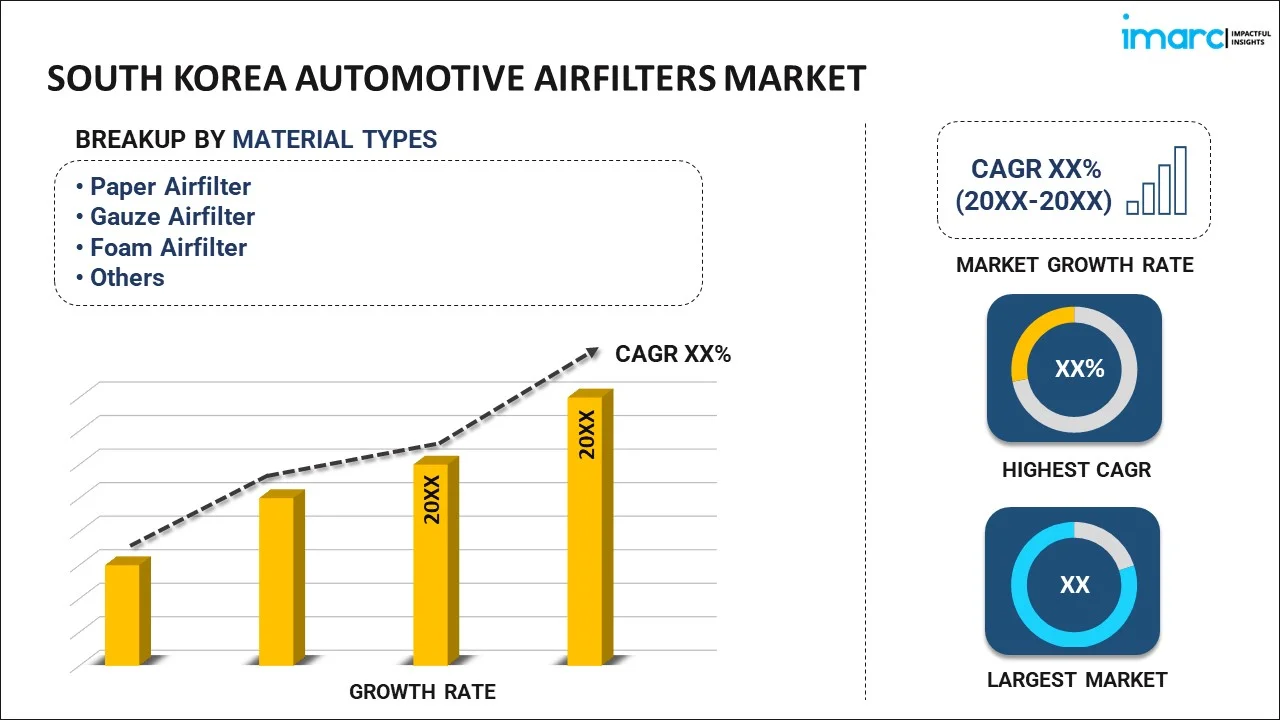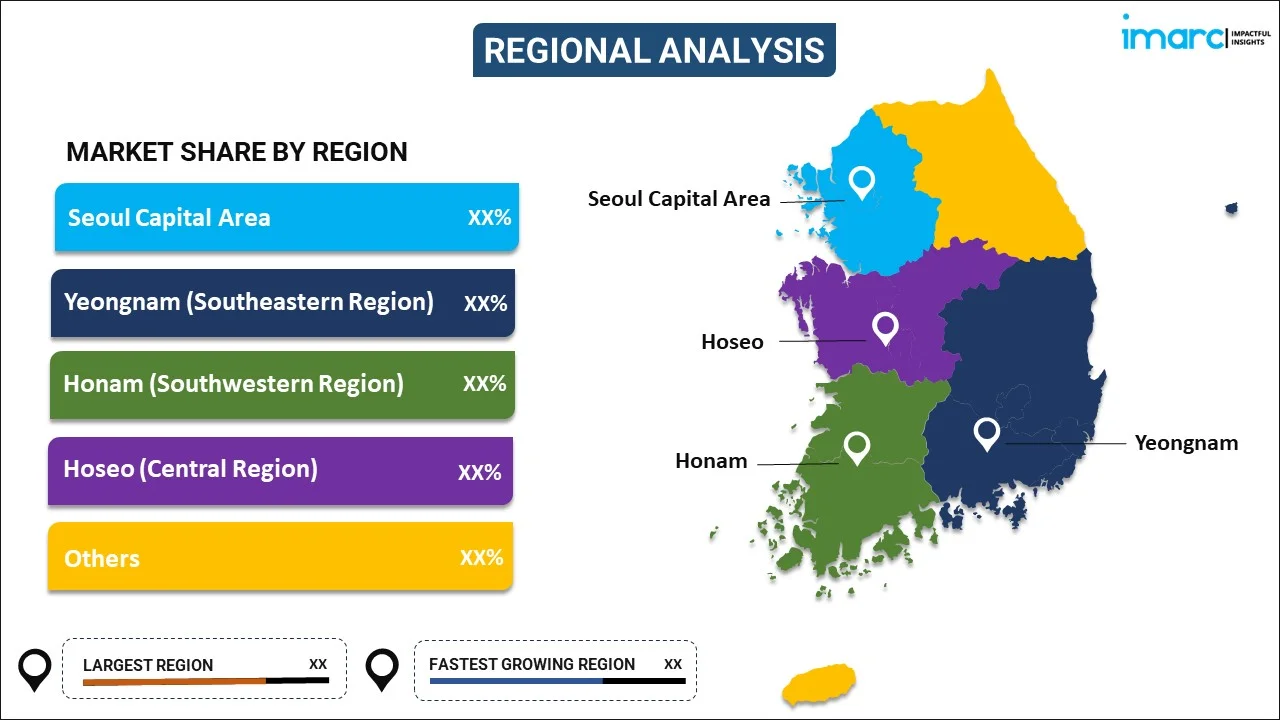
South Korea Automotive Airfilters Market Report by Material Type (Paper Airfilter, Gauze Airfilter, Foam Airfilter, and Others), Type (Intake Filters, Cabin Filters), Vehicle Type (Passenger Cars, Commercial Vehicles), Sales Channel (OEMs, Aftermarket), and Region 2024-2032
Market Overview:
The South Korea automotive airfilters market size reached US$ 8.64 Billion in 2023. Looking forward, IMARC Group expects the market to reach US$ 18.17 Billion by 2032, exhibiting a growth rate (CAGR) of 7.70% during 2024-2032. The growing number of automobile owners, the development of advanced engine technologies, and growing awareness among vehicle owners about the importance of regular maintenance of automotive airfilters represent some of the key factors driving the market.
|
Report Attribute
|
Key Statistics
|
|---|---|
|
Base Year
|
2023 |
|
Forecast Years
|
2024-2032 |
|
Historical Years
|
2018-2023
|
| Market Size in 2023 | US$ 8.64 Billion |
| Market Forecast in 2032 | US$ 18.17 Billion |
| Market Growth Rate (2024-2032) | 7.70% |
Automotive air filters are essential components in vehicles that maintain the engine's health and performance. These filters are developed to clean the air that enters the engine, ensuring that only clean and contaminant-free air is used for combustion. They are produced of pleated paper or other materials that can capture dust, pollen, dirt, and other particles present in the air. They draw in air through the air filter into the engine's intake manifold. The filter traps these airborne particles, preventing them from entering the engine's combustion chambers. They can protect the engine from harmful contaminants and provide clean air, which is efficient combustion and allows the engine to burn fuel effectively, improving fuel efficiency and reducing emissions. Additionally, a clean air supply prolongs the life of the engine by preventing abrasive particles from causing premature wear and tear on critical components. It is recommended to replace or clean the air filter according to the manufacturer's guidelines to maintain optimal engine function.
South Korea Automotive Airfilters Market Trends:
The South Korea automotive air filter market is primarily driven by the increasing number of automobile owners in South Korea due to the well-developed automotive industry and the rising middle-class population with the purchasing power to buy cars. Moreover, several technological advancements and manufacturers have improved vehicle performance and efficiency through the development of advanced engine technologies that require more effective air, representing another major growth-inducing factor. Along with this, automotive air filter manufacturers in South Korea are providing high-quality filters that can handle the latest engine technologies, which is propelling the market growth. Besides this, the implementation of government regulations and policies regarding air quality and emissions standards is encouraging the adoption of automotive air filters, which is accelerating the market growth. Also, stricter regulations led automakers to incorporate advanced filtration systems, driving the demand for high-quality air filters. Apart from this, rapid urbanization led to increased traffic congestion in major cities, resulting in higher levels of airborne pollutants and contaminants. As a result, the need for reliable and efficient automotive air filters to ensure the quality of air inside the vehicle cabin is augmenting the market growth. Additionally, the growing awareness among vehicle owners about the importance of regular maintenance to extend the lifespan of their vehicles is creating a positive market outlook. Furthermore, changing the air filter is a simple and effective maintenance task that can improve engine performance and fuel efficiency, resulting in a growing number of airfilter replacements, creating a positive market outlook.
South Korea Automotive Airfilters Market Segmentation:
IMARC Group provides an analysis of the key trends in each segment of the market, along with forecasts at the country level for 2024-2032. Our report has categorized the market based on material type, type, vehicle type, and sales channel.
Material Type Insights:

- Paper Airfilter
- Gauze Airfilter
- Foam Airfilter
- Others
The report has provided a detailed breakup and analysis of the market based on the material type. This includes paper airfilter, gauze airfilter, foam airfilter, and others.
Type Insights:
- Intake Filters
- Cabin Filters
A detailed breakup and analysis of the market based on the type have also been provided in the report. This includes intake filters and cabin filters.
Vehicle Type Insights:
- Passenger Cars
- Commercial Vehicles
The report has provided a detailed breakup and analysis of the market based on the vehicle type. This includes passenger cars and commercial vehicles.
Sales Channel Insights:
- OEMs
- Aftermarket
A detailed breakup and analysis of the market based on the sales channel have also been provided in the report. This includes OEMs and aftermarket.
Regional Insights:

- Seoul Capital Area
- Yeongnam (Southeastern Region)
- Honam (Southwestern Region)
- Hoseo (Central Region)
- Others
The report has also provided a comprehensive analysis of all the major regional markets, which include Seoul Capital Area, Yeongnam (Southeastern Region), Honam (Southwestern Region), Hoseo (Central Region), and Others.
Competitive Landscape:
The market research report has also provided a comprehensive analysis of the competitive landscape in the market. Competitive analysis such as market structure, key player positioning, top winning strategies, competitive dashboard, and company evaluation quadrant has been covered in the report. Also, detailed profiles of all major companies have been provided.
South Korea Automotive Airfilters Market Report Coverage:
| Report Features | Details |
|---|---|
| Base Year of the Analysis | 2023 |
| Historical Period | 2018-2023 |
| Forecast Period | 2024-2032 |
| Units | US$ Billion |
| Scope of the Report | Exploration of Historical Trends and Market Outlook, Industry Catalysts and Challenges, Segment-Wise Historical and Future Market Assessment:
|
| Material Types Covered | Paper Airfilter, Gauze Airfilter, Foam Airfilter, Others |
| Types Covered | Intake Filters, Cabin Filters |
| Vehicle Types Covered | Passenger Cars, Commercial Vehicles |
| Sales Channels Covered | OEMs, Aftermarket |
| Regions Covered | Seoul Capital Area, Yeongnam (Southeastern Region), Honam (Southwestern Region), Hoseo (Central Region), Others |
| Customization Scope | 10% Free Customization |
| Report Price and Purchase Option | Single User License: US$ 3699 Five User License: US$ 4699 Corporate License: US$ 5699 |
| Post-Sale Analyst Support | 10-12 Weeks |
| Delivery Format | PDF and Excel through Email (We can also provide the editable version of the report in PPT/Word format on special request) |
Key Questions Answered in This Report:
- How has the South Korea automotive airfilters market performed so far and how will it perform in the coming years?
- What has been the impact of COVID-19 on the South Korea automotive airfilters market?
- What is the breakup of the South Korea automotive airfilters market on the basis of material type?
- What is the breakup of the South Korea automotive airfilters market on the basis of type?
- What is the breakup of the South Korea automotive airfilters market on the basis of vehicle type?
- What is the breakup of the South Korea automotive airfilters market on the basis of sales channel?
- What are the various stages in the value chain of the South Korea automotive airfilters market?
- What are the key driving factors and challenges in the South Korea automotive airfilters?
- What is the structure of the South Korea automotive airfilters market and who are the key players?
- What is the degree of competition in the South Korea automotive airfilters market?
Key Benefits for Stakeholders:
- IMARC’s industry report offers a comprehensive quantitative analysis of various market segments, historical and current market trends, market forecasts, and dynamics of the South Korea automotive airfilters market from 2018-2032.
- The research report provides the latest information on the market drivers, challenges, and opportunities in the South Korea automotive airfilters market.
- Porter's five forces analysis assist stakeholders in assessing the impact of new entrants, competitive rivalry, supplier power, buyer power, and the threat of substitution. It helps stakeholders to analyze the level of competition within the South Korea automotive airfilters industry and its attractiveness.
- Competitive landscape allows stakeholders to understand their competitive environment and provides an insight into the current positions of key players in the market.
Need more help?
- Speak to our experienced analysts for insights on the current market scenarios.
- Include additional segments and countries to customize the report as per your requirement.
- Gain an unparalleled competitive advantage in your domain by understanding how to utilize the report and positively impacting your operations and revenue.
- For further assistance, please connect with our analysts.
 Inquire Before Buying
Inquire Before Buying
 Speak to an Analyst
Speak to an Analyst
 Request Brochure
Request Brochure
 Request Customization
Request Customization




.webp)




.webp)












